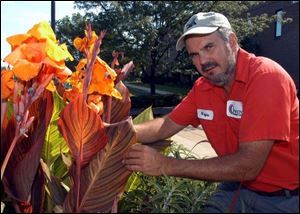
Raising cannas can add big bursts of color
8/20/2003If you're looking for a summer garden show-off, consider cannas.
Wayne Strayer, grounds foreman at Owens Community College, says cannas can make a garden stand up and be noticed - in more ways than one.
First, the tropical plants are tall. Some varieties grow up to 12 feet, making them great plants for the back of a border or against a building.
And second, their foliage and flowers are colorful. The foliage is often dark green, sometimes turning bronze with red markings, and the bright blossoms include vivid reds, pinks, oranges, and yellows.
The Cannaceae genus has 60 species. They love the hot and humid weather of late summer and are just cresting into their peak blossoming season.
For lush-looking cannas, Mr. Strayer says he and his staff top dress the plants in June by sprinkling the tops with slow-release fertilizer or compost, then they give the plants' foliage a feeding by adding a 20-20-20 fertilizer to the water at least once a week.

Wayne Strayer with some of the cannas growing at Owens Community College.
In warmer climates, cannas are considered perennials. But in northwest Ohio and southeast Michigan, they need to be stored during winter.
“After a hard frost, the foliage turns brown and ugly,” Mr. Strayer says. “We will tag the plants, noting their color, then cut the stalk down to six inches above the soil line. It gives us a good handle to work with and helps pull the rhizome [fleshy stems growing below the soil level] out of the ground.”
Mr. Strayer and his staff set the rhizomes out on tarps for three to four days to let them dry, then cut off the stub.
“This is also a good time to divide the larger rhizomes and cut off any bad or soft spots on them,” he says. “You don't want to store any diseased rhizomes because that will spread to the others in the container.”
When separating the rhizomes, Mr. Strayer and his staff keep at least one bud on each rhizome. They clean off all the dirt and even trim off the roots growing out of the rhizome, then wrap each clean rhizome in newspaper and store in a cardboard box lined with a trash bag.
“We store all cannas by color in a box lined with a trash bag. I don't seal the bag, but fold the cardboard flaps in to keep the box closed. There are other ways to store your rhizomes. We sometimes use shredded paper, and I have heard of other people storing them in peat, but we think newspapers work very well and they are always available.”
Mark the outside of the box clearly with the color and name of the canna lilies so they will be easy to find in the spring. Keep them in a cool, dry place that won't freeze over the winter.
Mr. Strayer and his staff start the rhizomes in the greenhouse in March. “We will put one rhizome in a one-gallon pot filled with sterilized potting soil.” He keeps them in the light and waters them weekly until planting them after the frost-free date in May each year and starts the blooming process all over again.